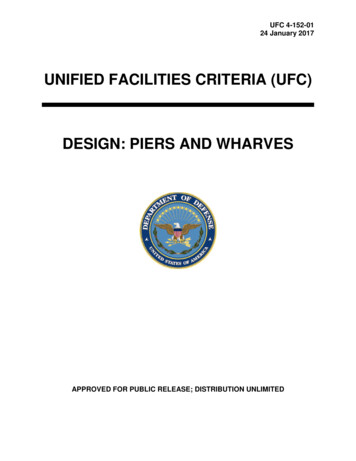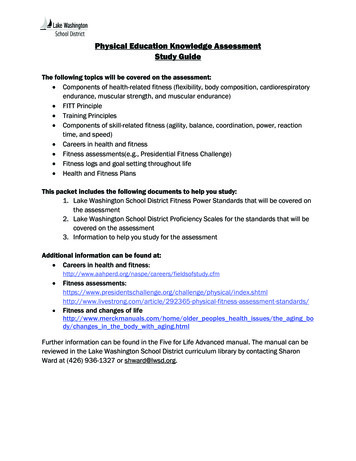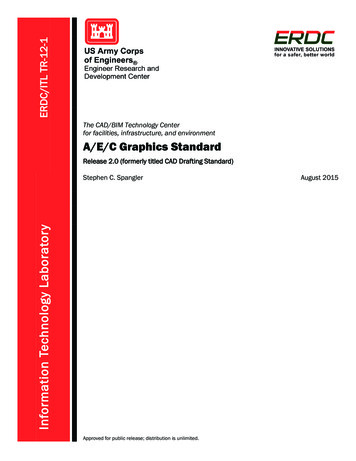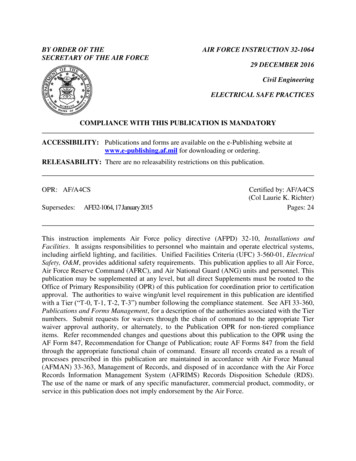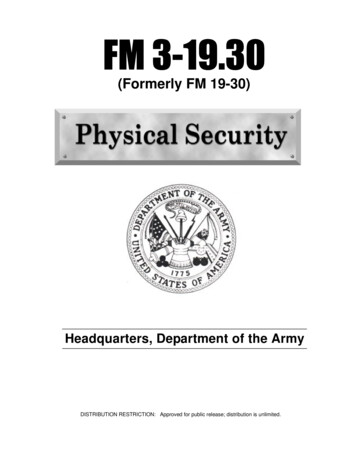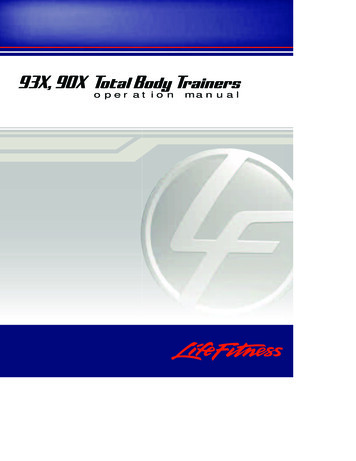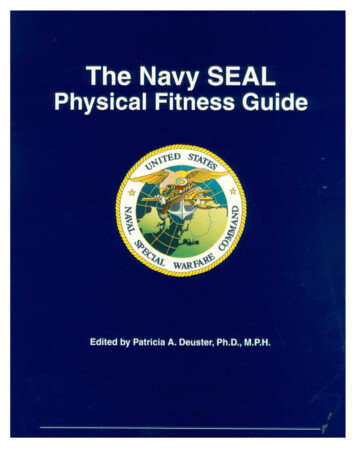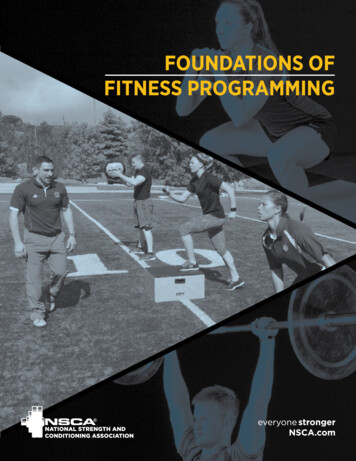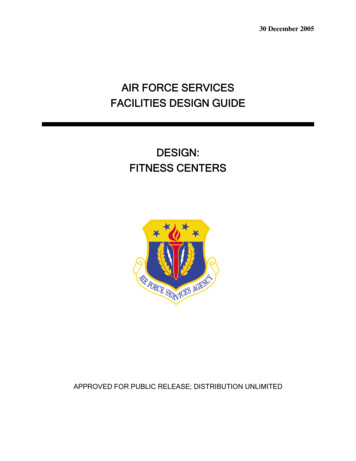
Transcription
30 December 2005AIR FORCE SERVICESFACILITIES DESIGN GUIDEDESIGN:FITNESS CENTERSAPPROVED FOR PUBLIC RELEASE; DISTRIBUTION UNLIMITED
30 December 2005AIR FORCE SERVICES FACILITIES DESIGN GUIDE (AFSFDG)FITNESS CENTERSAny copyrighted material included in this AFSFDG is identified at its point of use. Use ofthe copyrighted material apart from this AFSFDG must have the permission of the copyrightholder.AIR FORCE SERVICES AGENCYRecord of Changes (changes are indicated by \1\ . /1/)Change No.DateLocation21070821-Jul-08Resources and Links: Updated links provided inparagraph 7.3The format of this document conforms to UFC 1-300-01; however, it is an Air Force-onlydocument not included in the UFC (Unified Facilities Criteria) system.
30 December 2005FOREWORDThe Air Force Services Facilities Design Guide (AFSFDG) provides planning, design,construction, sustainment, restoration, and modernization criteria, and applies to US AirForce Services projects. AFSFDGs will be used for all Air Force projects and work forother customers where appropriate.AFSFDGs are living documents and will be periodically reviewed, updated, and madeavailable to users for providing functional and technical criteria for military construction.Headquarters, U.S. Air Force Services Agency (AFSVA) is the OPR for this AFSFDG.This document has been coordinated and reviewed by AF/ILEC (Air Force Office of theCivil Engineer). Contact AFSVA for document interpretation and improvements.This and other AFSVA Facilities Design Guides may be found at the AF Services AgencyCommunity of Practice website p?Tab 0&FolderID OO-DP-AE-12-35-1416&Filter OO-DP-AE-12 . Hard copies of documents printed from electronic media should bechecked against the current electronic version prior to use to ensure that they are current.
30 December 2005TABLE OF CONTENTSCHAPTER 1 - INTRODUCTION . 11-1PURPOSE AND SCOPE. . 11-2DOCUMENT USERS. . 11-3FITNESS FACILITY DESCRIPTION. . 11-3.1Fitness Mission . 11-3.2Requirements. 21-4DOCUMENT ORGANIZATION. . 21-5LIMITATIONS. 21-6GUIDE GOALS. 2CHAPTER 2 - PLANNING AND PROGRAMMING . 42-1OVERALL CONSIDERATIONS. 42-1.1Project Team. 42-1.2Project Planning . 42-1.3Project Site Planning. . 72-2FACILITY SPACE DISTRIBUTION . 82-2.12-3General Considerations. . 8COST CONSIDERATIONS. . 102-3.1Site Cost Considerations. 102-3.2Building Systems Cost Considerations. . 102-3.3Building Design Cost Considerations. . 102-3.4Other Design Cost Considerations. . 112-4PROJECT EXECUTION. . 112-4.1Design and Construction Process. . 11CHAPTER 3 - GENERAL DESIGN CRITERIA . 123-1SITE SELECTION AND DESIGN . 123-1.1General Site Design Considerations. . 123-1.2Circulation . 133-1.3Parking. . 143-1.4Site Design Considerations. . 143-1.5Site Amenities. . 143-1.6Landscape Architecture. . 153-2BUILDING DESIGN. . 15i
30 December 20053-2.1Architectural Character . 163-2.2Codes and Standards . 163-3BUILDING SYSTEMS . 183-3.1Structural . 183-3.2Heating, Ventilation, and Air Conditioning (HVAC) . 183-3.3Plumbing . 193-3.4Electrical . 193-4FURNITURE, FIXTURES AND EQUIPMENT . 21CHAPTER 4 - FUNCTIONAL AREA DESIGN CRITERIA . 224-1VISITOR & SPECTATOR SUPPORT . 234-1.1Vestibule . 234-1.2Lobby . 234-1.3Control Point/Reception . 244-1.4Retail . 254-1.5Public Restrooms . 254-1.6Corridors and Hallways . 254-2Administration . 264-2.1Fitness Center Director's Office . 264-2.2Sports Program Manager’s Office . 264-2.3Operation’s Manager’s Office. 264-2.4NCOIC’s Office . 274-2.5Staff Workroom . 274-2.6Conference/Classroom . 274-3SUPPORT . 274-3.1Storage . 284-3.2Janitorial . 284-3.3Laundry . 284-3.4Equipment Repair . 294-3.5Service Entrance and Receiving . 294-4LOCKER ROOMS . 294-4.1Dressing Room . 304-4.2Showers . 314-4.3Restrooms. 324-4.4Sauna Room . 32ii
30 December 20054-4.5Steam Room . 324-5GYMNASIUM . 334-6UNIT PT/GROUP EXERCISE . 354-7FITNESS EQUIPMENT SPACES . 374-7.2Fitness Assessment Room . 394-8RACQUETBALL COURTS . 404-9TRACK . 414-10HEALTH AND WELLNESS CENTER . 414-10.1Reception/Waiting/Library . 424-10.2Office Space . 424-10.3Classrooms . 434-10.4Ergometry and Fitness Testing . 434-10.5Wellness Assessment Room . 434-10.6Janitor Closet/Storage/Restrooms . 434-10.7Equipment Demonstration Room . 444-11ENHANCED AREAS . 444-11.1Lap Pool . 444-11.2Distinguished Visitors (DV) Locker Rooms . 464-11.3Family Locker Room . 464-11.4Parent/Child Area (PCA) . 464-11.5HAWC Relaxation Room. 474-11.6HAWC Kitchen/Food Demonstration Area . 474-11.7Massage Room . 484-11.8Expanded Retail Area . 484-11.9Juice Bar . 484-11.10 Spa Area . 484-11.11 Outdoor Fitness Trail or Par Course . 494-12BUILDING SUPPORT AREAS . 49CHAPTER 5 - ILLUSTRATIVE DESIGNS. 505-1SMALL FACILITY. 515-2LARGE FACILITY . 52CHAPTER 6 - SPORT FLOORING . 53CHAPTER 7 - RESOURCES AND LINKS . 557-1GOVERNMENT . 55iii
30 December 20057-2DEPARTMENT OF DEFENSE PUBLICATIONS: . 557-3DEPARTMENT OF THE AIR FORCE . 557-3.1Air Force Policies . 567-3.2Air Force Guides . 577-4RELATED NON-GOVERNMENT RESOURCES . 57CHAPTER 8 - ACRONYMS. 59CHAPTER 9 - SPACE CALCULATOR ASSUMPTIONS . 61FIGURESFigure 1-1 Fitness Center and Health and Wellness Center, Andersen AB, Guam. 1Figure 2-1 Fitness Center and Health and Wellness Center Site Planning . 7Figure 3-1 Fitness Center, Ellsworth AFB . 12Figure 3-2 Landscape . 15Figure 4-1 Lobby . 22Figure 4-2 Fitness Center Functional Diagram . 23Figure 4-3 Fitness Center Lobby Functional Diagram . 24Figure 4-4 Automatic External Defibrillator. 25Figure 4-5 Fitness Center Administration Area Functional Diagram . 26Figure 4-6 Fitness Center Support Area Functional Diagram . 28Figure 4-7 Locker Rooms Functional Diagram . 30Figure 4-8 Gymnasium Functional Diagram. 34Figure 4-9 Boxing Equipment. 35Figure 4-10 Unit PT/Group Exercise Functional Diagram . 36Figure 4-11 Group Exercise Room. 37Figure 4-12 Fitness Equipment Functional Diagram . 38Figure 4-13 Fitness Equipment . 38Figure 4-14 Racquetball Functional Diagram . 40Figure 4-15 Elevated Track . 41Figure 4-16 Health and Wellness Center Functional Diagram . 42Figure 4-17 Lap Pool. 45Figure 4-18 Parent/Child Area . 46Keesler AFB MS . 46Figure 5-1 Small Fitness Center Plan . 51Figure 5-2 Large Fitness Center Plan . 52iv
30 December 2005TABLESTable 2-1:Base Classification and Authorized Scope for Fitness Centers with a HAWC* 6Table 2-2:Core and Enhanced Spaces . 9Table 6-1:Sports Flooring Performance Characteristics . 54v
30 December 2005CHAPTER 1 - INTRODUCTION1-1PURPOSE AND SCOPE.This guidance implements construction policies and processes approved for FitnessCenters. These standards advance the goal of achieving consistent, enhanced qualityfacilities at all installations. Developing and implementing facilities to achieve fitnessfacility excellence will help sustain a strong, productive, and viable Air Force.This design guide is intended to: Highlight guidelines and criteria that should be considered during the evaluation,planning, programming, and design processes. Provide a consolidated listing of additional resources where more detailedinformation can be obtained. Present an appropriate USAF image for fitness facilities by organizing criteria into aconcise user-friendly format for evaluating new or renovated fitness facilities.The information in this guide applies to the design of all new construction projects as wellas to major and minor renovation projects at main operating bases and reserve bases.While the space allocation in the guide does not apply to stand-alone Air National Guard(ANG) bases, the information in the guide may be used to help design the ANG fitnessrooms at these locations, i.e., identify type of flooring, space per equipment items, etc.Specifically, it provides guidelines for determining required spaces, technical requirements,installation location, site design, and fitness facility space design.The guide provides basic information and references that should be consulted in order toprogram, design, and execute a successful fitness facility project. Chapter 7 providesrelated AF documents and other related applicable government and industry referencedocuments.Figure 1-11-2Fitness Center and Health and Wellness Center, Andersen AB, GuamDOCUMENT USERS.This guide was developed for those who plan, operate, and evaluate Fitness Centers. It isalso written so design architects, engineers, programmers, and planners can achieveconsistent and enhanced quality fitness facilities throughout the Air Force.1-3FITNESS FACILITY DESCRIPTION.1-3.1.Fitness MissionThe Air Force Fitness mission is to “Enhance combat readiness by supporting unitcommanders’ fitness program and provide fitness and sports opportunities to all authorizedusers.”1
30 December 20051-3.2.RequirementsThe Air Force Fitness Facility requirement is to “Facilitate the readiness, fitness, andmorale of Air Force members by providing effective, efficient, and pleasant spaces forindividual and group exercise, unit physical training (PT), team and individual sports,testing, training/education, and necessary support.” The Fitness Facility shall providespaces for the following functions: Fitness Equipment Spaces Unit PT and Group Exercise Fitness Testing Fitness Training Team and Individual Sports: intramural, extramural, varsity Administrative Functions Support Functions Health and Wellness1-4DOCUMENT ORGANIZATION.The criteria are organized to parallel the design process: Programming Criteria provides the basic guidelines for sizing and configuring afacility and includes diagrams that clarify the desired relationships betweenfunctions, as well as a table summarizing scope requirements for each facility. Design Criteria covers information relevant to all phases of design and containsguidelines for organizing the site and designing and planning the building's utilities,layout, character and circulation, and systems. Functional Area and Space Guidelines provide detailed design requirements foreach functional space in a typical facility. It includes diagrams that can aid in thepreparation of preliminary and working drawings. Illustrative Design Information contains examples of floor plans that show how theguide's design principles can be applied to a particular project. Resources and Links1-5LIMITATIONS.This guide must be used in conjunction with DOD and other documents that give relatedguidance. Unique design requirements of a specific project will be addressed at theinstallation level. This design guide is not a substitute for research required byprogrammers and designers. Further, programmers and designers must incorporateinstallation and Major Command design requirements.1-6GUIDE GOALS.This design guide is intended to promote: Compliance with current policies, yet includes flexibility to meet local needs,2
30 December 2005 Understanding of AF fitness goals and their implications for facility design, and Teamwork from requirements identification through beneficial occupancy.3
30 December 2005CHAPTER 2 - PLANNING AND PROGRAMMING2-1OVERALL CONSIDERATIONS.This chapter identifies the requirement for new and existing fitness facilities for Air Forceinstallations. The space criteria shall determine the number and size of the coreelements for each installation.2-1.1Project TeamThe Project Team will identify and integrate applicable design criteria, site-specificdesign requirements, specific goals and strategies during programming, planning,design, and construction. Cooperation between participants representing allorganizations is critical to the success of any project. Therefore, the organizations andindividuals listed below should be involved early in the planning, programming, anddesign of a fitness facility to ensure that all functional requirements are met. Refer tothe USAF Project Manager's Guide (Project Definition Chapter) for informationconcerning the Design Team Participants from other organizations. Commanders Base Services Squadron/Division; Combat Support Flight Commander; FitnessCenter Director and Staff Base Civil Engineering Squadron; Project Manager; Trades representatives Installation Medical Group; Health Promotion Manager or Health Educator Headquarters, Air Force Services Agency fitness (SVPAF) and facilities (SVXFB)representatives Architectural and Engineering Consultants Contracting Officer Planners, Architects, Landscape Architects, Engineers, Interior Designers Base Support Team including Fire Department, Security Forces, Environmental,Bioenvironmental Engineering Safety, and other appropriate representatives Major Command Services and Civil Engineering representatives Others as appropriate2-1.2Project Planning2-1.2.1Overall Project Scope. The base population is the initial determinant forthe total combined scope (space authorization) of all fitness facilities on an installation.For purposes of fitness center facility sizing, base population is defined by the followingcategories. See base population computation worksheet. Assigned military personnel: Including Air Force other U.S. military personnel,full-time Air Force Reserve, and Air National Guard; authorized military personnelincluded in interservice support agreements with other U.S. services; andauthorized military personnel included in support agreements with foreign/NATOservices.4
30 December 2005 Family members: Fifty (50) percent of family members from assigned militarypersonnel aged 13 years or older. Military transient population: When the installation regularly serves a substantialnumber (over 100) of military transients (PCS members, students, or membersTDY) greater than 30 consecutive days, the average daily strength, based on afirm projection of the total yearly load of such transients, may be added to thebase population. Use the following formula:(Number of 30 day TDYs* x length in calendar days) x Frequency per year / # ofdays Fitness Center is open per year** Average Daily TDY Load*30 day TDYs include exercises, recurring courses, and other 30 -day TDYs.**Assume that Fitness Center is open 363 days per year.EXAMPLE:Course 1 - (200 persons X 60 days) * 6 times a year / 363 Course 2 - (50 persons X 90 days) * 2 times a year / 363 Exercise 1 - (550 persons X 179 days) * 1 times a year / 363 Total Average Daily TDY Load19825271494For overseas bases, include: Assigned DOD civilians: Include NAF, AAFES, and DODEA (Department ofDefense Education Activity) personnel as part of the base population. Do notinclude personnel as DOD civilians if they are counted as family members. For PACAF and USAFE: Include assigned military members of host nations orNATO alliances to the base population if written in the host nation agreement.In accordance with AFRCH 32-1001, Standard Facility Requirements, Air ReserveBases (ARB), will follow this design guide. A fitness center at an ARB will have aminimum of 17,000SF dedicated to fitness spaces and no space dedicated to a Healthand Wellness Center (HAWC). When planning fitness facility projects, provide corespaces and enhanced spaces not found in other adequate installation facilities. Forbases with multiple fitness facilities, ensure at least one facility includes all the corespaces. Enhanced spaces may be included at the discretion of the installationcommander, but may not displace core spaces. Consider mission, weather, andcustomer demand when deciding to include indoor pools or whether a steam room orsauna is preferred. The space allocation for core and enhanced areas vary by theinstallation size. Flexibility and expansion requirements are significant issues to beaddressed during the design of all facilities. The following table shows the baseclassifications and related space authorizations:5
30 December 2005Table 2-1:yBase Classification and Authorized Scope for Fitness Centers with a HAWC*CategorSmallPopulation Brackete SFAllowablSM01,00055,0295,112Medium 11,0012,00062,2295,781Medium 22,0013,00069,4296,450Medium 33,0014,00076,6297,119Medium ga 16,0017,00098,2369,126Mega 27,0018,000103,2369,591Mega 38,0019,000108,23610,055Mega 49,00110,000113,23610,520Mega 510,00111,000118,23610,984Mega 611,00112,000123,23611,449Mega 712,00113,000128,23611,913Mega 813,00114,000133,23612,378Mega 914,00115,000138,23612,842Mega 1015,00116,000143,23613,307Mega 1116,00117,000148,23613,771Mega 1217,00118,000153,23614,236Mega 1318,00119,000158,23614,700Mega 1419,00120,000163,23615,165Mega 1520,00121,000168,23615,629Mega 1621,00122,000173,23616,094Mega 1722,00123,000178,23616,558Mega 1823,00124,000183,23617,023Mega 1924,00125,000188,23617,487Mega 2025,00126,000193,23617,952Mega 2126,00127,000198,23618,416Mega 2227,00128,000203,23618,881Mega 2328,00129,000208,23619,345Mega 2429,00130,000213,23619,810* See separate Space Calculator worksheet.6
30 December 20052-1.2.2Project Requirements and Acquisition Planning.Develop a Requirements Document/Project Management Plan (RD/PMP) orRequirements and Management Plan (RAMP) that provides the design agent and thedesigner with information used in negotiating the design contract and completing theproject definition phase. Use the information in this guide as the basis for developingmajor design issues, requirements, and costs as part of the RD. The PMP should alsoidentify facility acquisition decisions. Refer to the USAF Project Managers’ Guide forDesign and Construction for useful information on developing a RD/PMP or RAMP.2-1.3Project Site Planning.The selected site must be approved by the local installation commander and should bepart of the base general plan. Preferably, the fitness facility should be located neardormitories, housing, community centers, outdoor sports facilities/fields, and othercompatible facilities.The selected site should allow for future expansion of the facility, parking, and outdooractivities, as required. Many factors should be carefully evaluated when determining thesite. These considerations should include things such as the availability and capacity ofrequired utilities, mass/scale of the facility relative to adjacent structures, proximity tohistorical districts, and relationships to existing vehicular and pedestrian circulationpatterns.Figure 2-1Fitness Center and Health and Wellness Center Site Planning7
30 December 20052-2FACILITY SPACE DISTRIBUTION2-2.1General Considerations.The Space List and Area Recommendations are minimum guidelines. The size of thecore areas will vary with the size of the installation. The total scope of all core areas will not exceed the authorized scope of coreareas for the installation. However, the core areas must be present at each AirForce Installation before any enhanced areas are added. At least one fitness facility on an installation will contain all the core spaces. Enhanced areas above the core area authorized must be justified for each areaadded.Table 2-1 identifies the space allocation for small to mega-24 facilities. Table 2-2 listscore areas for the fitness center and the HAWC (exception: the HAWC is not a corespace on Reserve installations). All core spaces must be included before optionalenhanced spaces may be added to the project. The total core space area must bew
individual and group exercise, unit physical training (PT), team and individual sports, testing, training/education, and necessary support.” The Fitness Facility shall provide spaces for the following functions: Fitness Equipment Spaces Unit PT and Group
